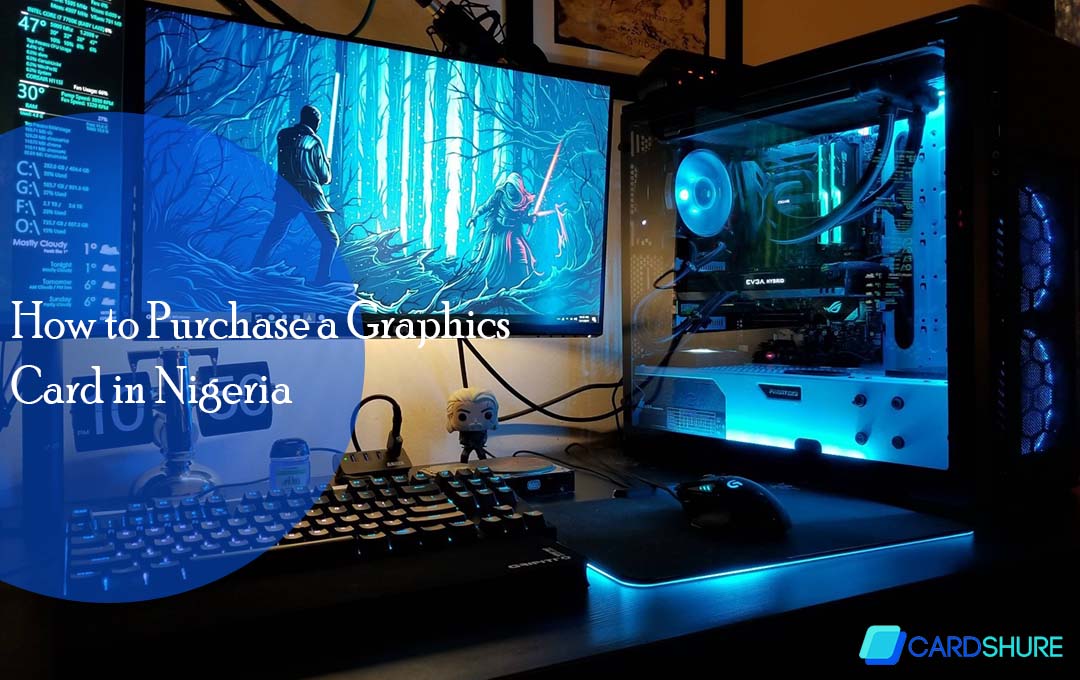A graphic card is very essential for anyone who wants to engage in gaming or editing videos using their PC. In this context, I will be giving you details on how to determine which graphics card to purchase based on your budget and specific needs.

Although gaming PC is not a common factor in Nigeria, people still go around to get them, and if you happen to be among the few, then these tips are for you.
Things You Need to Know Before Buying a Graphics Card
You must have a Balanced gaming PC or a video editing device. This dedicated graphics card would help settle all your issues. And it can’t compensate for a poor monitor, slow SSD, or even other hardware.
Below are some major key areas you need to think about before deciding to purchase a graphics card.
- Cost
- Processor/memory
- Laptop vs. Desktop
- Features
- Availability
Graphics Card Cost in Nigeria
Like a lot of gaming PC components, a graphics card price can vary. And sometimes, with the rate of dollars in Nigeria at the moment, you might find getting a really good graphics card to be very expensive.
The thing with graphics cards is that the less you pay the more compromises you would need to make. However, that doesn’t mean it is not worth purchasing a graphics card in some cases. Sometimes, purchasing a graphics card as a part of a prebuilt system is a lot cheaper than buying it individually.
You can buy a budget graphics card for around N150k, and a mid-range graphics card for around N250k to 400k, while if you want something top-notch, you should consider spending N750k to N1M. these prices are usually influenced by the price of the dollar.
What Processor and Memory Does a Graphics Card Need?
When considering the processor and memory requirements for a graphics card, two key components are essential: the GPU (Graphics Processing Unit) and VRAM (Video Random Access Memory).
GPU: The GPU is the heart of the graphics card. It’s responsible for rendering images, video, and animations. The performance of a GPU is determined by factors like core count, clock speed, and architecture. Higher-end GPUs will have more cores and higher clock speeds, offering better performance, especially for gaming and graphic-intensive tasks.
VRAM: VRAM is the memory dedicated to storing image data that the GPU processes. More VRAM allows a graphics card to handle higher resolutions, more complex textures, and better anti-aliasing. For most users, 4GB to 6GB of VRAM is sufficient, but gamers and professionals using 3D applications may benefit from 8GB or more.
The balance between GPU and VRAM is crucial. A powerful GPU with insufficient VRAM can lead to bottlenecks, while too much VRAM with a weaker GPU may not provide the expected performance boost. Therefore, when selecting a graphics card, it’s important to consider the specific needs of your applications and games and choose a card with a suitable combination of GPU power and memory.
What Features Are There with Graphics Cards?
Graphics cards, crucial for rendering images and videos on computers, come with a variety of features that enhance their performance and user experience:
- GPU Cores: The number of cores in a GPU determines its processing power. More cores typically mean better performance in rendering and handling graphics-intensive tasks.
- Memory (VRAM): Video RAM (VRAM) is dedicated memory for storing graphical data. More VRAM allows a card to handle higher resolutions and more detailed textures. Standard amounts range from 2GB to 12GB or more, depending on the card’s intended use.
- Clock Speed: The clock speed of a GPU impacts how quickly it can process data. Higher clock speeds can lead to improved performance, especially in gaming and 3D rendering.
- Ray Tracing: This is a feature in newer, high-end graphics cards that allows for more realistic lighting and shadows in 3D environments. It’s particularly important for gamers and professionals in 3D modeling and rendering.
- Cooling Systems: Graphics cards generate a lot of heat. Efficient cooling systems, which may include fans, heat sinks, or liquid cooling, are essential to maintain performance and longevity.
- Ports and Connectivity: Modern graphics cards offer a range of ports like HDMI, DisplayPort, and sometimes USB-C, allowing them to connect to various displays and support multiple monitor setups.
- Power Consumption and Supply Requirements: Higher-performance graphics cards often require more power and may need a more powerful power supply unit (PSU).
These features collectively determine the capability of a graphics card. Choosing the right combination depends on the specific needs, such as gaming, professional graphic design, or general multimedia use.
